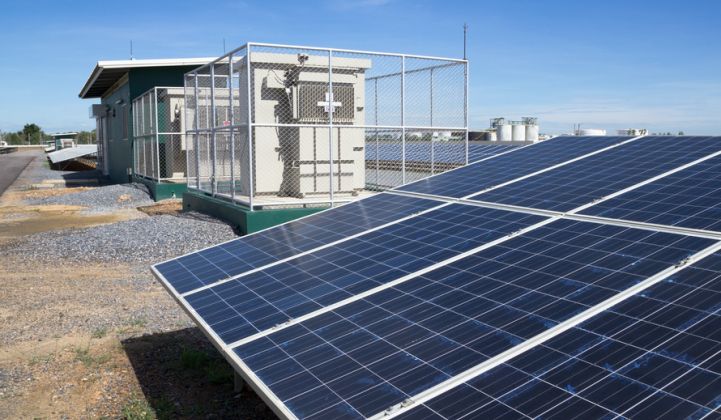Imagine a state that has enacted all of the policies that the public and clean energy providers have asked for: an aggressive renewable portfolio standard, a robust grid modernization plan, far-reaching shared renewables. The sun is shining, the birds are chirping, people are celebrating and getting ready to build new projects -- perfect, right?
Unfortunately, there could be dark clouds on the horizon without the one policy most critical to making everything else work: interconnection.
The absence of this crucial policy would cause projects to because mired in a murky technical process, with no end in sight.
Does this sound too pessimistic to be real? It’s not. Just ask Minnesota, New York and several other states that have learned the hard way about the importance of interconnection.
The power grid is much like our network of country roads, highways and freeways, carrying energy from its origin to its final destination. Interconnection standards are, in effect, the “rules of the road,” set by policymakers, which both system owners and utilities must follow to keep traffic flowing smoothly. The quality of these rules -- like any given street sign, traffic direction or roadmap -- can facilitate an easy free-flow of traffic, or result in maddening, unnecessary gridlock. As we introduce new technologies and services, such as self-driving cars and ride-sharing apps, the rules of the road must evolve. So, too, must interconnection procedures.
Drawing from our experience working on the ground with more than 20 states on interconnection reform, the Interstate Renewable Energy Council (IREC) puts forward-thinking, fact-based tools in the hands of stakeholders and decision-makers tackling the challenges of a more distributed electricity grid. In the weeks ahead, we will discuss key emerging issues and critical areas of focus for decision-makers. We will also identify a host of best practices that have not yet been captured in existing interconnection model rules.
At a basic level, interconnection standards should outline with clarity all of the timelines, fees, technical requirements and steps in the review process for bringing new systems on-line. Well-designed rules are foundational to healthy renewable energy markets, as they allow utilities to maintain the safety and reliability of the grid, while providing a transparent, efficient and cost-effective experience for customers. Interconnection should not be an obstacle or a source of frustration and contention for any party involved in the process. Clear, forward-thinking rules are essential if we want to achieve our clean energy goals.
In 2016, just over half of all states earned either an “A” or “B” grade in Freeing the Grid, a report that IREC and Vote Solar release annually, which tracks developments in interconnection and net metering policies across the country. Approximately 20 percent of states received a “C” or “D” grade for poorly designed rules, and 30 percent got an “F,” having failed to adopt interconnection standards of any kind. But those states that are further behind on interconnection have an advantage: They can look to the examples of pioneering states, such has California, Hawaii and Massachusetts, which have recently adopted strong procedural reforms to improve interconnection.
At the national level, the Federal Energy Regulatory Commission (FERC) has also developed a set of standards for small generators and utilities under its jurisdiction. A number of states, such as North Carolina, South Carolina, Ohio, and most recently Illinois, have followed FERC’s lead, incorporating its “fast-track” review process and other best practices into their own interconnection rules. Others, including Minnesota and Iowa, are actively considering similar updates.
As an active participant at FERC and in dozens of state commission rulemakings over the past decade, IREC has identified and synthesized the best practices in use across the country in a set of model interconnection procedures that states should consider as they strive to create and refine their own rules. Key practices highlighted in IREC’s model procedures include the use of pre-application reports, updated technical screens, more sophisticated sizing criteria, an improved “supplemental review” process that reduces the need for full study, and more.
Even in proactive states, higher volumes of renewable energy projects seeking to connect to the grid in the years ahead could create significant logjams if we do not meaningfully prepare with proactive rules. In some places, they already have.
Hawaii, California and Massachusetts were driven to reform their interconnection procedures in response to backlogged interconnection queues and frustrated customers. More recently, North Carolina experienced similar queue delays and took a hard look at its procedures. These states’ procedures and IREC’s model rules already capture some lessons learned -- but not all of them. In this article series, we will look at cutting-edge interconnection issues, and wherever possible, identify innovative solutions being implemented across the United States.
In this series, IREC will answer some of the most critical questions facing our collective clean energy future:
- How can states enforce improved interconnection processes and ensure accountability among developers and utilities alike?
- Who gets to access grid data, and what does it really mean to gain greater visibility into our distribution system?
- How do we keep costs reasonable amid rapidly increasing demand for interconnections? And who should pay for what (and when)?
- What’s the role for interconnection as we move toward a more modern and sophisticated electricity grid?
- What should we do when conflicts arise?
- What about storage? How do you connect energy storage to the grid?
Up next in the series: how clear timelines can make or break the interconnection process, and where applicants and utilities still get stuck today.
***
Erica McConnell is special counsel and Cathy Malina is an environmental law fellow with Shute, Mihaly and Weinberger LLP, attorneys for the Interstate Renewable Energy Council.



